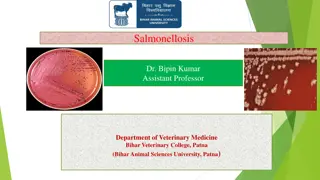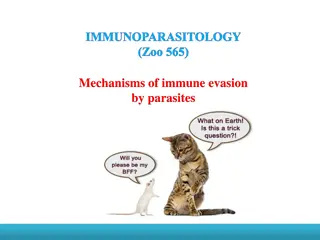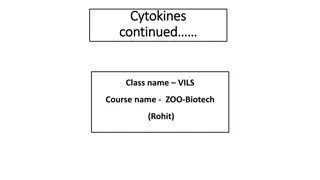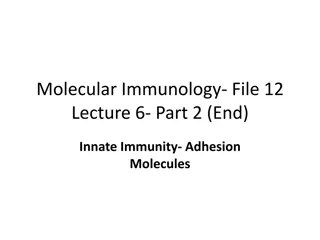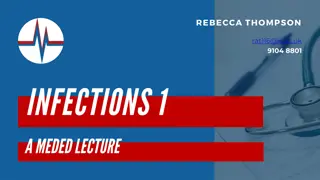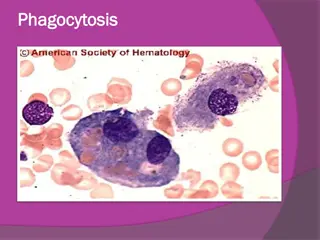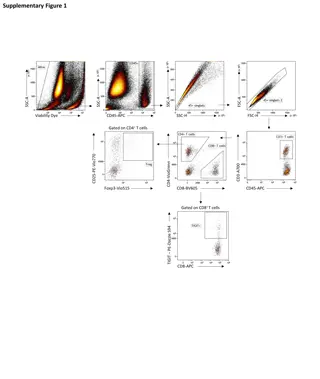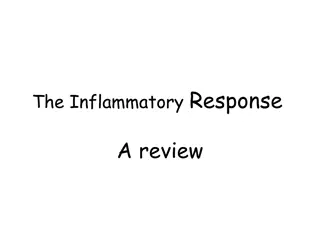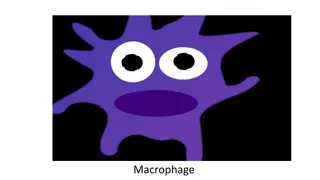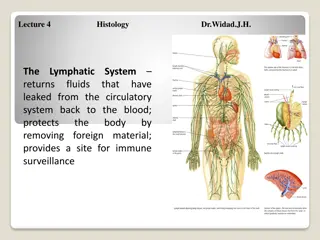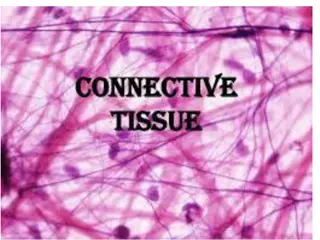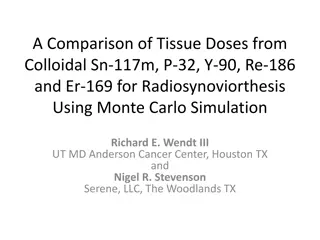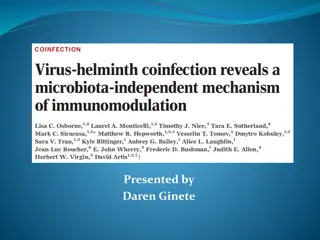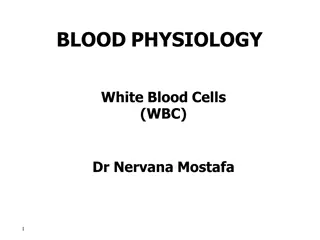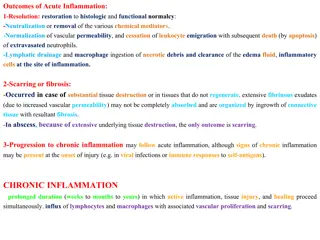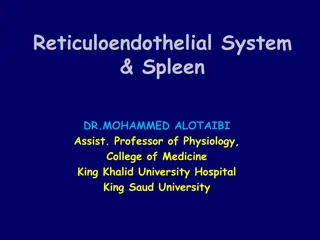White Blood Cells: Defense Mechanisms and Functions
White blood cells, specifically neutrophils and macrophages, play crucial roles in defending the body against infections. Neutrophils attack and destroy bacteria in the blood while macrophages, once matured in tissues, combat intratissue disease agents. These cells exhibit unique abilities such as d
7 views • 52 slides
Salmonellosis: Causes, Clinical Presentations, and Transmission
Salmonellosis is caused by the gram-negative bacterium Salmonella enterica. It predominantly affects warm-blooded vertebrates, leading to carrier states, septicemia, enteritis, and other clinical presentations like abortion and arthritis. The disease is transmitted through contaminated foods of anim
0 views • 15 slides
Mechanisms of Immune Evasion by Parasites in Immunoparasitology
Understanding how parasites evade the immune system of their hosts is crucial in the field of immunoparasitology. Parasites have developed various strategies such as anatomical seclusion, antigenic variation, and intracellular living to avoid host immune responses. Examples include Plasmodium within
0 views • 26 slides
The Significance of Cytokines in Immune Response
Cytokines play a crucial role in immune response activation and regulation. They are secreted by various cell types like lymphocytes, monocytes, and macrophages, exerting diverse biological functions, including immune system development, inflammatory response induction, and hematopoiesis regulation.
2 views • 12 slides
Role of Adhesion Molecules in Immune Response to SARS-CoV-2 Engagement
Engagement of SARS-CoV-2 triggers the complement system and TLR 7 in neutrophils and macrophages, leading to the release of inflammatory cytokines and chemotactic factors. This results in the upregulation of adhesion molecules on blood capillary endothelial cells and leukocytes, facilitating leukocy
3 views • 12 slides
HIV: Transmission, Symptoms, and Management
HIV, a single-stranded, positive-sense, enveloped RNA retrovirus, is transmitted through various means such as sexual intercourse, vertical transmission, and blood contact. The virus targets T cells, macrophages, and other immune cells, leading to acute and chronic stages with distinct symptoms. As
0 views • 37 slides
The Role of Vitamin D in Reducing COVID-19 Risk
Vitamin D plays a crucial role in reducing the risk of COVID-19 by enhancing the body's immune response, reducing production of pro-inflammatory cytokines, and increasing anti-inflammatory cytokines. Individuals at greater risk include the elderly, those with chronic diseases, dark-skinned individua
0 views • 23 slides
Phagocytosis, Inflammation, and Granulomas in Tuberculosis
Phagocytosis is a crucial process where cells engulf and digest pathogens. Inflammation responses involve various immune cells like neutrophils, plasma cells, lymphocytes, and macrophages. Granulomas, typical in diseases like tuberculosis, are mass accumulations in chronic inflammation. Tuberculosis
0 views • 18 slides
Immunology: Key Players and Processes
Explore the world of immunology through key components such as monocytes, macrophages, lymphocytes, interferons, and the inflammatory reaction. Learn about the roles of various immune cells in defending the body against pathogens and the mechanisms of inflammation in response to tissue damage or inf
0 views • 16 slides
Immune Cell Analysis Supplementary Figures
This collection of supplementary figures provides detailed flow cytometry data on immune cell populations, including CD4+ T cells, CD8+ T cells, tumor-associated macrophages, and more. The figures also include information on immune checkpoint molecules like PD-L1 and TIGIT. Each figure presents spec
0 views • 4 slides
The Inflammatory Response Mechanism
The inflammatory response is a crucial defense mechanism of the immune system. It comprises three lines of defense aimed at protecting the body from harmful pathogens. When a barrier is breached, such as by a splinter carrying bacteria, the inflammatory process is initiated. This includes the releas
1 views • 25 slides
Journey of Immune Cells in the Body
Explore the different stages of the immune response, starting with macrophages in the innate immune system that act fast without memory. Follow the path to the spleen and lymph nodes where T cells, already educated at birth to recognize specific antigens, await. Witness the intricate dance of the im
0 views • 18 slides
Haemolytic Anaemias: Causes and Classification
Haemolytic anaemias result from increased red cell destruction, involving normal red cell breakdown processes like extravascular removal by macrophages. This breakdown leads to the liberation of iron, bilirubin circulation, and protein synthesis. An introduction to haemolytic anaemias explains how t
0 views • 27 slides
Overview of the Lymphatic System and Immune Response
The lymphatic system plays a crucial role in returning leaked fluids back to the blood, protecting the body from foreign materials, and supporting immune surveillance. It consists of lymphoid cells such as T and B lymphocytes, macrophages, dendritic cells, and reticular cells that work together to d
0 views • 31 slides
Connective Tissues: Characteristics, Classification, and Types
Connective tissues play a crucial role in supporting and connecting various tissues in the body. They are highly vascularized and develop only from mesoderm during embryonic origin. Consisting of cells and intercellular matter secreted by the cells, these tissues are categorized based on cell types
0 views • 109 slides
Comparison of Tissue Doses from Various Radionuclides for Radiosynoviorthesis
This study compares tissue doses from different radionuclides - Sn-117m, P-32, Y-90, Re-186, and Er-169 - for radiosynoviorthesis using Monte Carlo simulation. It explores electron range, half-life, and therapeutic absorbed doses to synovial tissues, presenting a hypothesis on the selection of radio
0 views • 12 slides
Safety and Pharmacodynamic Activity of Vesatolimod (GS-9620) in HIV-Infected Individuals
Vesatolimod (GS-9620) has shown to be safe and pharmacodynamically active in individuals infected with HIV. Studies demonstrate its potential to eliminate and activate infected CD4 T cells, recruit immune cells like NK cells and macrophages, and work in combination with broadly neutralizing antibodi
0 views • 21 slides
Helminths and Immunomodulation: A Comprehensive Study
Helminths, parasitic organisms affecting a large part of the global population, can modify the immune response through immunomodulation. This research delves into the interaction between helminths, microbiome, and immune response, exploring the effects on macrophages, alternative activation, and the
0 views • 28 slides
White Blood Cell Physiology and Function
Explore the formation, maturation, and functions of white blood cells, focusing on eosinophils, basophils, monocytes, and macrophages. Learn about the roles of these cells in immune responses, including phagocytosis, allergic reactions, and defense against parasites. Gain insights into the complex p
0 views • 24 slides
Acute and Chronic Inflammation: Causes, Outcomes, and Resolution
Acute inflammation results in either resolution or progression to chronic inflammation, with outcomes like restoration of normalcy, fibrosis, or scarring. Chronic inflammation can be caused by viral infections, persistent microbial infections, exposure to toxic agents, or autoimmune diseases. Macrop
0 views • 27 slides
Reticuloendothelial System and Spleen
The lecture sheds light on the Reticuloendothelial System (RES) and spleen, explaining their cellular components, functions, and importance in the immune system. It details how macrophages in various organs form part of the RES, emphasizing their role in filtering and destroying foreign particles. T
0 views • 27 slides
Engulfment
Phagocytosis is a crucial process in the immune system where cells engulf and kill infectious agents. Learn about the steps involved, from particle binding to degradation within neutrophils and macrophages. Discover how oxygen-dependent and -independent mechanisms work to eliminate pathogens efficie
0 views • 42 slides
Granulomatous Inflammation and Differential Diagnosis
Distinctive pattern of chronic inflammatory reaction characterized by focal accumulations of activated macrophages, causes, recognition in biopsy specimens, types of granulomas, and TB granuloma diagram.
0 views • 22 slides
Lymphatic System Function and Immune Response Overview
The lymphatic system plays a crucial role in maintaining fluid balance, immune surveillance, and protection against foreign invaders. It includes lymphoid cells such as T and B lymphocytes, macrophages, and dendritic cells, which work together to defend the body. The immune response involves T cells
0 views • 23 slides
Challenges in Canine OA Pain Management
The Canine OA Pain Management market faces major gaps in joint replacement, high risk for older pets, daily drug reliance, and inadequate treatment options. Synovial macrophages play a key role in driving destructive responses in osteoarthritis. Radiosynoviorthesis offers a potential solution with p
0 views • 18 slides
Histology
Connective tissue plays a vital role in connecting, supporting, and protecting the body. It consists of cells and extracellular matrix invaded by blood vessels and nerves. The ground substance, composed of mucopolysaccharides like hyaluronic acid, fills the space between cells, while fibers such as
0 views • 21 slides

